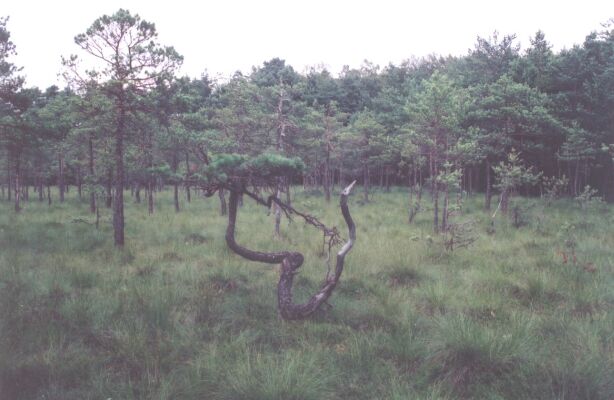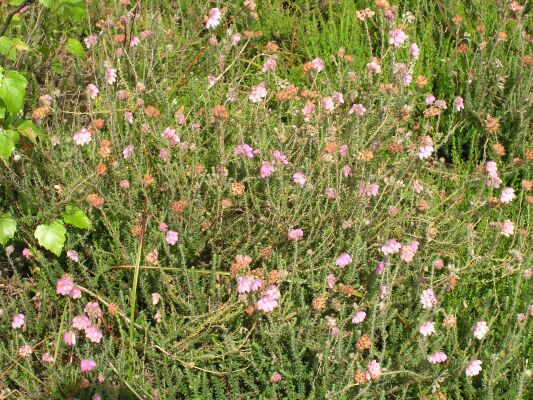 Baltic raised bogs (= "true raised bogs" according to Ellenberg 1988) are special kind of raised bogs, with limited distribution - around the Baltic see. These are typically ombrotrophic, oligotrophic and acidic; as a result they are covered by special kind of vegetation, with many rare and endangered plants.
Typical for baltic bog is a cupola shape peat bog deposit, with flat plateau and slopes. For the natural baltic raised bogs, plateau is typically treeless, with typical microrelief of hollows and hummocks. Slopes are covered by bog woodlands. For transformed bogs, cover of the whole bog by the pine or birch bog forest is typical. Baltic raised bogs are as a rule big complexes of natural habitats of European importance: *7110 - active raised bogs (priority!), 7120 - degraded but still capable for regeneration raised bogs, *91D0 - bog woodlands (priority!); with pine bog forests and Betula-Sphagnum bog forests among them.
Ca 80 baltic raised bogs were recorded in norhtern Poland, but no more than 30 are preserved till now. In the Pomerania region, 23 sites, giving any chance for maintaining or restoring the favourable conservation status of bog as a whole, and natural bog habitats, were recorded. All these sites are selected to this project.
Formal, passive management, applicated as a rule to raised bogs in Poland till now, seems to be not appropriate to successful baltic bogs conserving. Even on the best preserved bogs, active management, with blocking old anthropogenic drainings, sometimes also with taking other conservation measures, seems to be necessary. Probably it is "the last minute" to stop degradation processes!
Objective: Overall objective of the project is: To maintain or restore the favourable conservation status of active raised bog (7110) and pine/birch bog forest habitats (91D0) and the favourable conservation status of its complexes - baltic raised bogs in Pomerania, Poland. Operational objectives are:
Baltic raised bogs (= "true raised bogs" according to Ellenberg 1988) are special kind of raised bogs, with limited distribution - around the Baltic see. These are typically ombrotrophic, oligotrophic and acidic; as a result they are covered by special kind of vegetation, with many rare and endangered plants.
Typical for baltic bog is a cupola shape peat bog deposit, with flat plateau and slopes. For the natural baltic raised bogs, plateau is typically treeless, with typical microrelief of hollows and hummocks. Slopes are covered by bog woodlands. For transformed bogs, cover of the whole bog by the pine or birch bog forest is typical. Baltic raised bogs are as a rule big complexes of natural habitats of European importance: *7110 - active raised bogs (priority!), 7120 - degraded but still capable for regeneration raised bogs, *91D0 - bog woodlands (priority!); with pine bog forests and Betula-Sphagnum bog forests among them.
Ca 80 baltic raised bogs were recorded in norhtern Poland, but no more than 30 are preserved till now. In the Pomerania region, 23 sites, giving any chance for maintaining or restoring the favourable conservation status of bog as a whole, and natural bog habitats, were recorded. All these sites are selected to this project.
Formal, passive management, applicated as a rule to raised bogs in Poland till now, seems to be not appropriate to successful baltic bogs conserving. Even on the best preserved bogs, active management, with blocking old anthropogenic drainings, sometimes also with taking other conservation measures, seems to be necessary. Probably it is "the last minute" to stop degradation processes!
Objective: Overall objective of the project is: To maintain or restore the favourable conservation status of active raised bog (7110) and pine/birch bog forest habitats (91D0) and the favourable conservation status of its complexes - baltic raised bogs in Pomerania, Poland. Operational objectives are:
